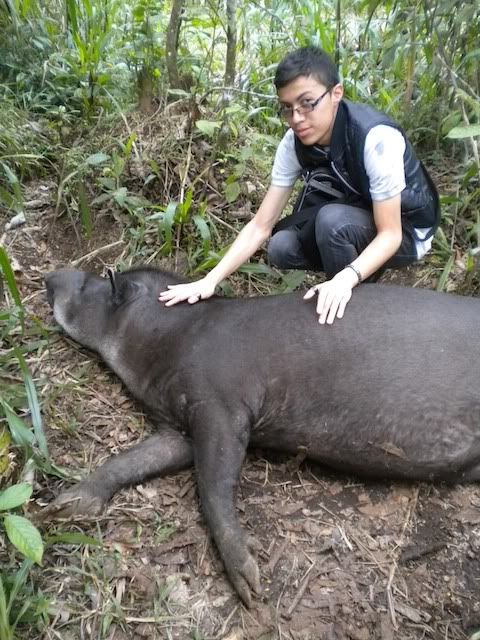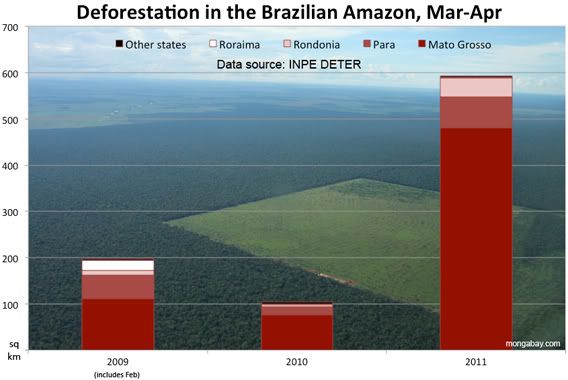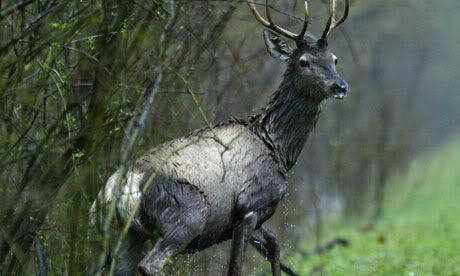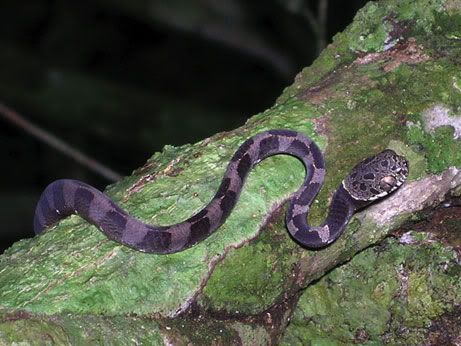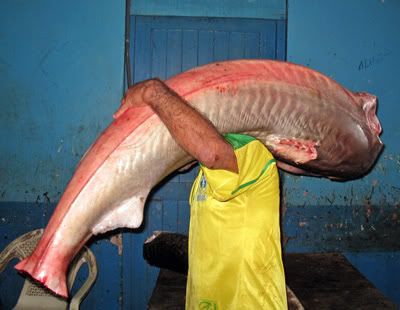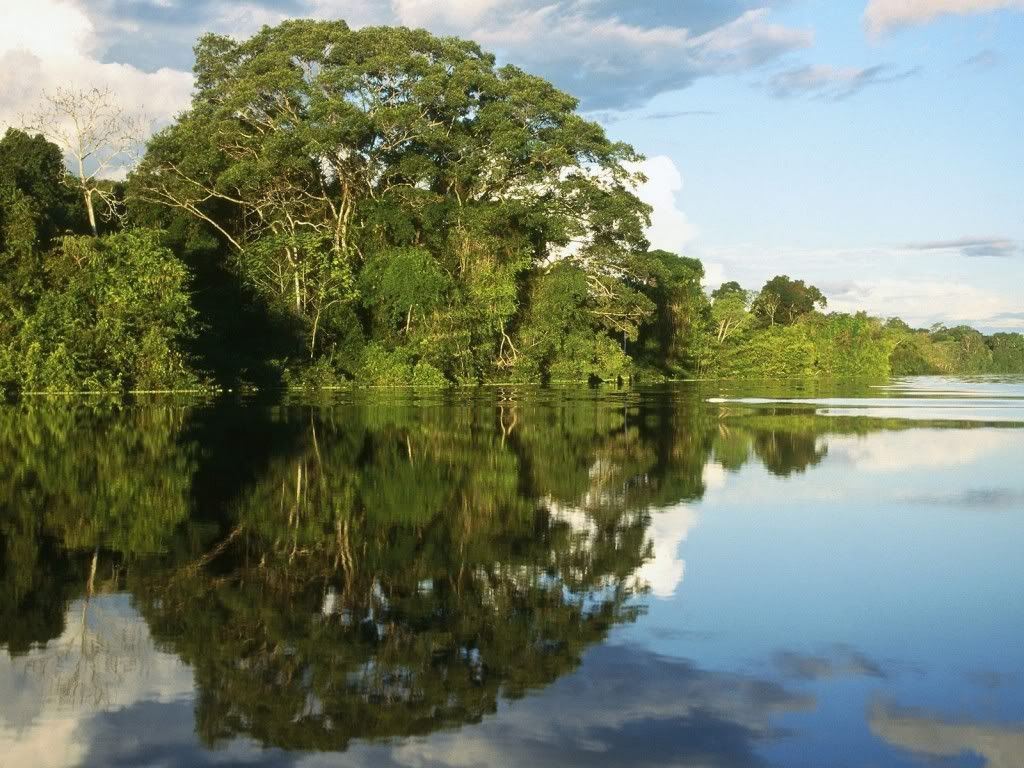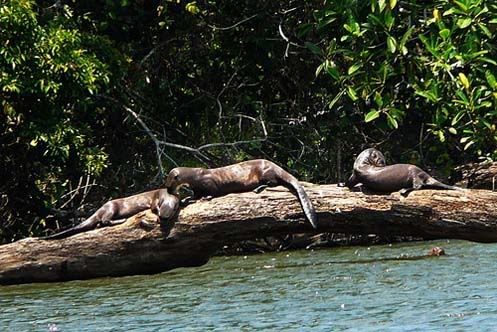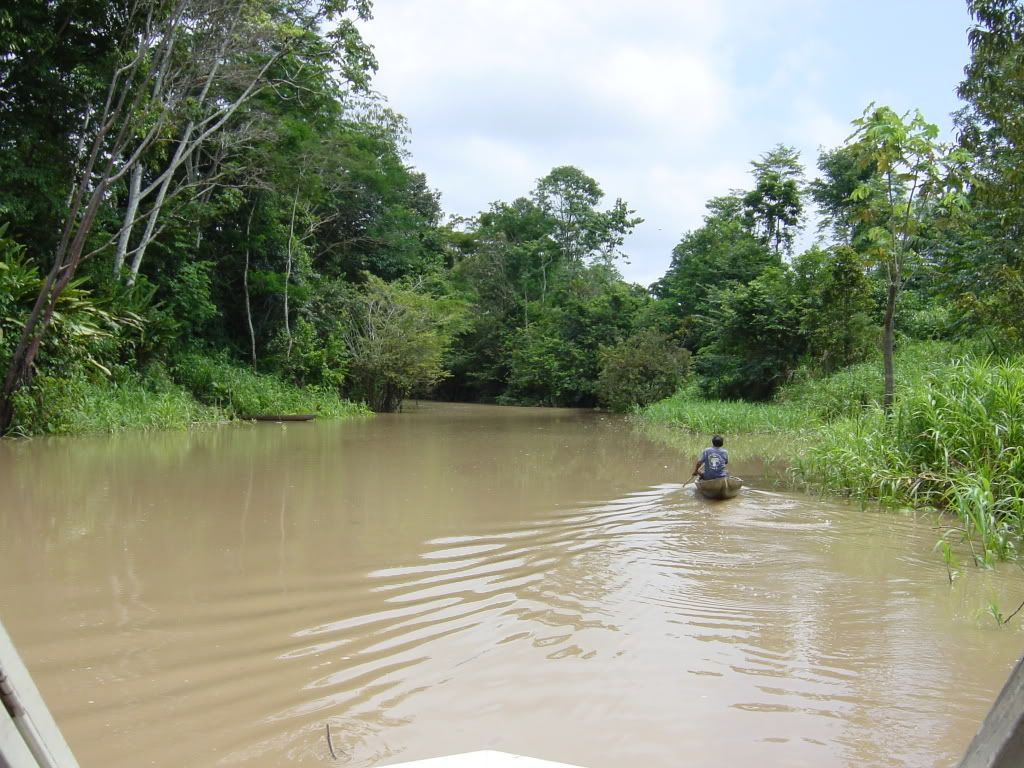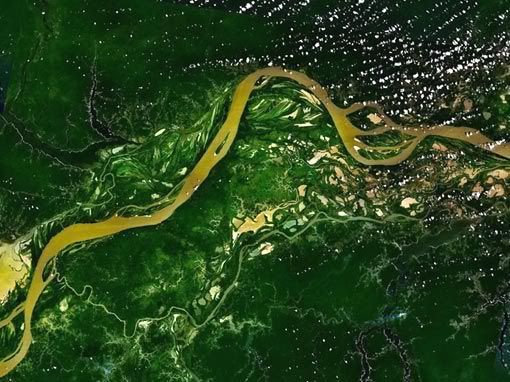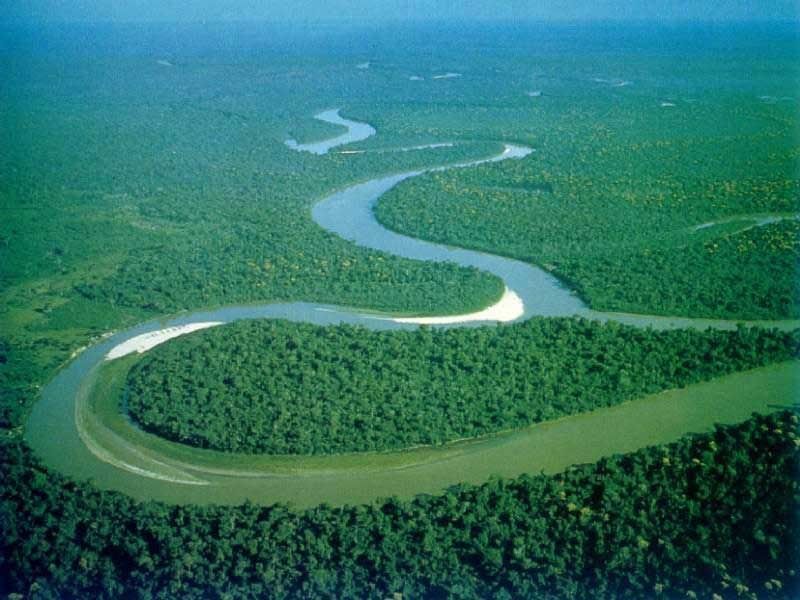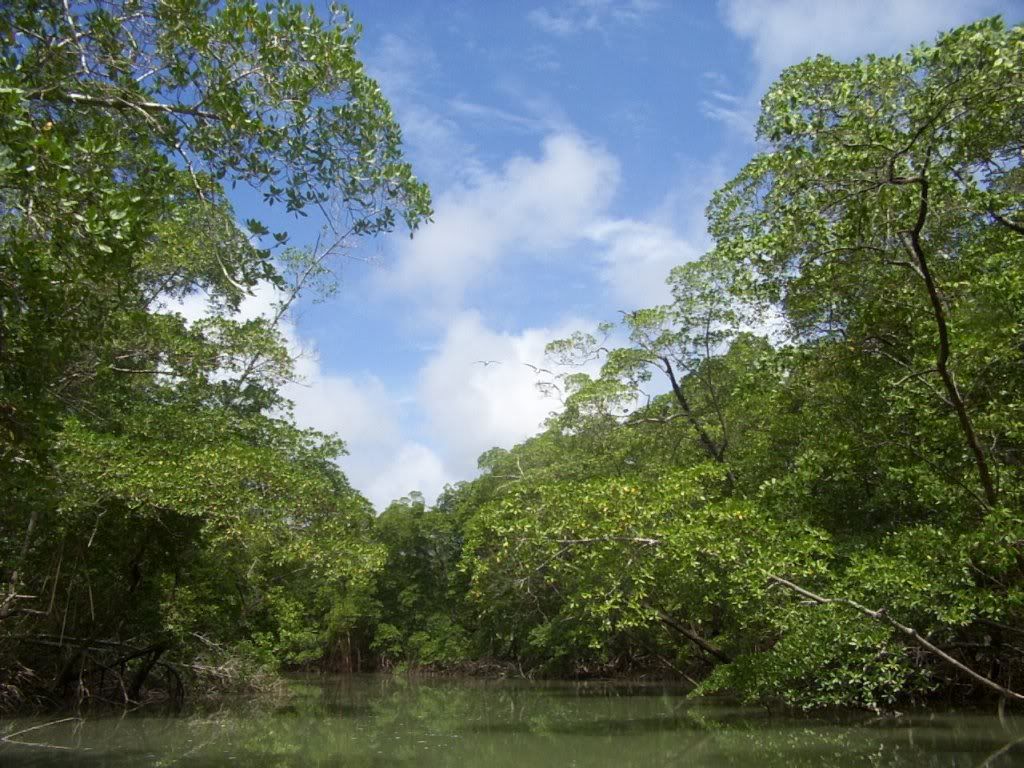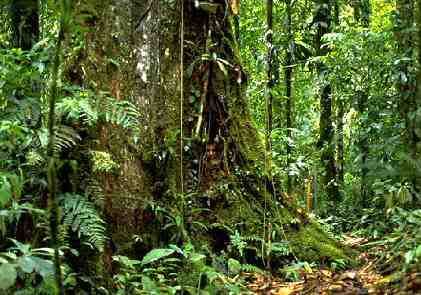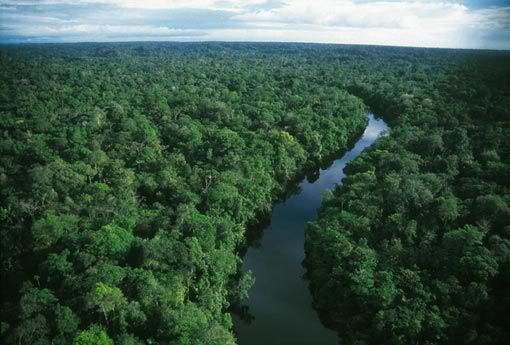A community leader in the Brazilian Amazon was slain Friday just three days after two environmentalists were killed in a neighboring state, reports Reuters.
Adelino "Dinho" Ramos, the president of the Movimento Camponeses Corumbiara e da Associação dos Camponeses do Amazonas, a small farmers association, was gunned down front of his family Friday morning in Rondônia. Brazil's Special Secretariat for Human Rights, an office of the president, said it was unclear who killed Ramos, who had received death threats from loggers. Ramos survived a 1995 massacre in which 13 people were killed.
His killing came just three days after Joao Claudio Ribeiro da Silva and his wife, Maria do Espirito Santo, were killed in an ambush near their home in the state of Pará. Suspicion immediately fell on illegal loggers linked to the charcoal trade that supplies pig iron smelters in the region. Da Silva had been a prominent environmentalist and the recipient of international recognition as well as numbers death threats.
Brazil's President Dilma Rousseff has already ordered a federal investigation into the murder of the da Silvas, which has been widely condemned.
Environmentalists say their death could catalyze further opposition to proposed changes to Brazil's Forestry Code, which would weaken protections for the Amazon rainforest. They cite the 1988 murder of rubber-tapper Chico Mendes, which helped spark global awareness of destruction of the Amazon rainforest, and the 2005 killing of Dorothy Stang, an American nun who opposed illegal logging and land-grabbing, which triggered a crack down by federal agents and the establishment of new protected areas.
The Brazilian Amazon remains a violent region. According to the Pastoral Land Commission (Comissão Pastoral da Terra) some 393 people were killed in rural land disputes between 2000 and 2010, including 71 murders in Rondonia since 2001. Crimes are rarely solved.
Tensions are presently high in the Brazilian Amazon due to rising commodity prices, which boost land values and exacerbates conflict. The agricultural lobby is pushing for a relaxation of the Forest Code to allow more rainforest to be cleared for crops and pastureland. The present Forest Code requires farmers and ranchers to maintain 80 percent forest cover on their land, although the rule is widely ignored.
Anticipation of amnesty for illegal deforestation under the new Forest Code is thought to be a contributing factor in a sharp rise in deforestation over land year.
Source: mongabay.com
mountains amazon river
mountains amazon river, river amazon information,the amazon river pictures, amazon river explorers, mountains amazon
Thứ Tư, 29 tháng 6, 2011
Danube brings visitors to unspoiled Baja, but also threat of pollution
Three massive carp are floundering in a pool in the middle of the yard as Balazs Barkuti prepares to cut them up, in keeping with the strict rules set for Danube fishers. This evening his family hotel is expecting 17 visitors from Budapest. They will be staying in Baja, overlooking the island of the same name in southern Hungary, 150km from the capital. Here halászlé, or fisherman's soup, is a must, to such an extent that a great stewpot hangs at the entrance to the picturesque town.
In summer, the Baja fish-soup festival attracts hordes of visitors to the town and to the nearby Gemenc national park. People here are said to eat more fish – 66kg a year on average – than anywhere else in Europe.
The nature reserve, with its many islands and quiet inlets, is still in more or less the same state as before the great river was regulated. The park is renowned for its century-old willows and great oaks, its black storks, trees and red deer.
"Ever since I was a child I have dreamt of living here," says Barkuti, 32. "The island hasn't changed in 100 years and I want it to stay the way it is for my two children to enjoy." Barkuti's dream came true five years ago when he left Budapest and a job stuck in front of a computer. "I enjoyed the excitement of the city but after a while I'd had enough," he says. "There aren't many places in the world you can find the peace and quiet we have here on the banks of the Danube."
However, in the course of its 2,850km journey across Europe, from the Black Forest in Germany to the Black Sea in Romania, the river suffers a great deal. Dams and reservoirs have damaged its reputation as a natural waterway, pollution and waste have soiled its water. Last year, toxic sludge was released into the Danube after a dam burst at an alumina plant. "In the morning I hear a series of tiny explosions," Barkuti says. "The reed beds along the river bank trap the plastic bottles as they float past. When the sun heats them up, they go pop!"
In September 2009, Hungary and Croatia agreed to protect the area between the Danube and the rivers Mura and Drava. This set in motion a process that culminated at the end of March when the first two countries were joined by Austria, Slovenia and Serbia. Together they established a trans-border Unesco biosphere reserve to protect Europe's Amazon, a scheme that the green campaigning group WWF had been advocating for about 10 years.
The new protected area extends over five countries, along 700km of river, and encompasses some 800,000 hectares of unique natural and historic landscape. It is Europe's largest riverine protected area.
The reserve is home to white-tailed sea eagles – with Europe's highest concentration of nesting pairs – and other endangered species such as little terns, black storks and sturgeon. It is also a vital stopover for more than 250,000 migrating birds.
"The rare species we see here know nothing about borders," says Tibor Parrag, head of nature conservation at the Danube-Drava national park. "It was essential to create a nature reserve to protect biodiversity. The agreement signed by the five countries will act as a catalyst for all of us."
This seems to suit local residents. Every year some 50,000 visitors flock to Baja (population 40,000). Cross-border protection of the Danube secures the region's future as a tourist destination. "Apart from tropical rainforest, there is no equivalent in terms of biodiversity to these flooded lowlands," says Arno Mohl, the Mura-Drava-Danube biosphere reserve project leader at WWF Austria. "The reserve will also play a key role in promoting eco-tourism. We hope the agreement will put an end to unsustainable schemes to regulate the rivers, as well as sand and gravel dredging, which still threatens this exceptional river ecosystem."
Under the European Union strategy for the Danube, decided on 13 April, which places considerable emphasis on environmental improvements, funding will be redirected to the nature reserve, which has yet to receive the Unesco seal of approval.
Along the riverfront in Baja the cafe terraces are packed. Barkuti is welcoming his guests, who have just arrived. He promises them a candle-lit dinner on the terrace overlooking his garden. "There was a time when we could drink the water from the Danube and use it for making soup," he says.
"I don't know if that'll be possible in the future, but if we stop throwing all our rubbish in the river, the fish will be pleased. And it make no sense dividing up the Danube with borders. The river will have a future if the countries join forces to protect it. The pact they've just signed is a good start."
In summer, the Baja fish-soup festival attracts hordes of visitors to the town and to the nearby Gemenc national park. People here are said to eat more fish – 66kg a year on average – than anywhere else in Europe.
The nature reserve, with its many islands and quiet inlets, is still in more or less the same state as before the great river was regulated. The park is renowned for its century-old willows and great oaks, its black storks, trees and red deer.
"Ever since I was a child I have dreamt of living here," says Barkuti, 32. "The island hasn't changed in 100 years and I want it to stay the way it is for my two children to enjoy." Barkuti's dream came true five years ago when he left Budapest and a job stuck in front of a computer. "I enjoyed the excitement of the city but after a while I'd had enough," he says. "There aren't many places in the world you can find the peace and quiet we have here on the banks of the Danube."
However, in the course of its 2,850km journey across Europe, from the Black Forest in Germany to the Black Sea in Romania, the river suffers a great deal. Dams and reservoirs have damaged its reputation as a natural waterway, pollution and waste have soiled its water. Last year, toxic sludge was released into the Danube after a dam burst at an alumina plant. "In the morning I hear a series of tiny explosions," Barkuti says. "The reed beds along the river bank trap the plastic bottles as they float past. When the sun heats them up, they go pop!"
In September 2009, Hungary and Croatia agreed to protect the area between the Danube and the rivers Mura and Drava. This set in motion a process that culminated at the end of March when the first two countries were joined by Austria, Slovenia and Serbia. Together they established a trans-border Unesco biosphere reserve to protect Europe's Amazon, a scheme that the green campaigning group WWF had been advocating for about 10 years.
The new protected area extends over five countries, along 700km of river, and encompasses some 800,000 hectares of unique natural and historic landscape. It is Europe's largest riverine protected area.
The reserve is home to white-tailed sea eagles – with Europe's highest concentration of nesting pairs – and other endangered species such as little terns, black storks and sturgeon. It is also a vital stopover for more than 250,000 migrating birds.
"The rare species we see here know nothing about borders," says Tibor Parrag, head of nature conservation at the Danube-Drava national park. "It was essential to create a nature reserve to protect biodiversity. The agreement signed by the five countries will act as a catalyst for all of us."
This seems to suit local residents. Every year some 50,000 visitors flock to Baja (population 40,000). Cross-border protection of the Danube secures the region's future as a tourist destination. "Apart from tropical rainforest, there is no equivalent in terms of biodiversity to these flooded lowlands," says Arno Mohl, the Mura-Drava-Danube biosphere reserve project leader at WWF Austria. "The reserve will also play a key role in promoting eco-tourism. We hope the agreement will put an end to unsustainable schemes to regulate the rivers, as well as sand and gravel dredging, which still threatens this exceptional river ecosystem."
Under the European Union strategy for the Danube, decided on 13 April, which places considerable emphasis on environmental improvements, funding will be redirected to the nature reserve, which has yet to receive the Unesco seal of approval.
Along the riverfront in Baja the cafe terraces are packed. Barkuti is welcoming his guests, who have just arrived. He promises them a candle-lit dinner on the terrace overlooking his garden. "There was a time when we could drink the water from the Danube and use it for making soup," he says.
"I don't know if that'll be possible in the future, but if we stop throwing all our rubbish in the river, the fish will be pleased. And it make no sense dividing up the Danube with borders. The river will have a future if the countries join forces to protect it. The pact they've just signed is a good start."
Rainforest destruction up by 500 per cent…and now Brazil relaxes protection laws
An alarming increase in deforestation in Brazil just as its government has agreed to relax laws protecting the country's forests.
In the Mato Grosso area, 405.6 square kilometres of forest were destroyed in April 2011, more than in the whole of the previous year and a staggering 540 per cent increase in deforestation month on month increase, according to the National Institute for Space Studies (INPE). Worse still, under the new bill, there would be an amnesty for those who illegally cleared forest before July 2008.
Supporters of the new law say Brazil needs land to boost agricultural production, while environmentalists say destruction of the Amazon rainforest will increase. It is not gaining full support, with Brazilian President Dilma Rousseff indicated she would veto any bill that contained an amnesty.
Environment Minister Izabella Teixeira expressed concern over the latest figures, saying: ‘This is a very serious fact, atypical and contradictory. In a single month there has been more deforestation in Mato Grosso than occurred in the whole of last year.
Increase in deforestation anticipated change in law
The proposed amendment to the law by the ‘ruralistas' would make profound alterations to the law, easing restrictions on farmers and requirements about how much they should replant. The changes were proposed by Aldo Rebelo form Brazil's Communist Party (PCdoB), who argued that the existing rules prevented small farmers from making best use of their land to lift themselves out of poverty and supported by groups representing farmers' interests.
Brazil's Forest Law (also known as the Forest Code) was first enacted in 1934 and determines how much a landowner can deforest and how much must be kept as a ‘legal reserve'. Before this month's decision, Brazil's Forest Law requires landowners in the Amazon to allow 80 per cent of a property to remain forested but in the tropical savannah region this falls to just 20 per cent. The final terms of the amended bill are still being debated.
The increase in deforestation is happening in regions where Mato Grosso's agribusiness is expanding, and is thought to be directly linked to the expectation that the amendment to the Forest Law will be approved.
Cleared to make way for soya production
Rainforest is being replaced by lucrative soya fields according to WWF-Brazil's Conservation Director Carlos Alberto de Mattos Scaramuzza: ‘The numbers reflect confidence in the promise made by the "ruralista" faction (representing agribusiness interests) in parliament that there will be a general amnesty for all illegal deforestation brought about by agribusiness.'
Much of the deforestation has been in the soya-growing region of Sinop, driven by spiraling market prices. On average, the profitability of soya is somewhere between 300 and 500 reais (£115 and £190) a hectare. But at the moment that has escalated to 1,000 reais (£380) a hectare, making it extraordinarily lucrative.
‘That assurance of extremely high profits associated with the expectation of generalised impunity as a consequence of the Forest Law amendment, has contributed immensely to stimulating the criminal deforestation we are witnessing in Mato Grosso today,' Scaramuzza said.
Mato Grosso - which translates to ‘Thick Wood' - is home to some of the most biodiverse swathes of rainforest in the country.
In the Mato Grosso area, 405.6 square kilometres of forest were destroyed in April 2011, more than in the whole of the previous year and a staggering 540 per cent increase in deforestation month on month increase, according to the National Institute for Space Studies (INPE). Worse still, under the new bill, there would be an amnesty for those who illegally cleared forest before July 2008.
Supporters of the new law say Brazil needs land to boost agricultural production, while environmentalists say destruction of the Amazon rainforest will increase. It is not gaining full support, with Brazilian President Dilma Rousseff indicated she would veto any bill that contained an amnesty.
Environment Minister Izabella Teixeira expressed concern over the latest figures, saying: ‘This is a very serious fact, atypical and contradictory. In a single month there has been more deforestation in Mato Grosso than occurred in the whole of last year.
Increase in deforestation anticipated change in law
The proposed amendment to the law by the ‘ruralistas' would make profound alterations to the law, easing restrictions on farmers and requirements about how much they should replant. The changes were proposed by Aldo Rebelo form Brazil's Communist Party (PCdoB), who argued that the existing rules prevented small farmers from making best use of their land to lift themselves out of poverty and supported by groups representing farmers' interests.
Brazil's Forest Law (also known as the Forest Code) was first enacted in 1934 and determines how much a landowner can deforest and how much must be kept as a ‘legal reserve'. Before this month's decision, Brazil's Forest Law requires landowners in the Amazon to allow 80 per cent of a property to remain forested but in the tropical savannah region this falls to just 20 per cent. The final terms of the amended bill are still being debated.
The increase in deforestation is happening in regions where Mato Grosso's agribusiness is expanding, and is thought to be directly linked to the expectation that the amendment to the Forest Law will be approved.
Cleared to make way for soya production
Rainforest is being replaced by lucrative soya fields according to WWF-Brazil's Conservation Director Carlos Alberto de Mattos Scaramuzza: ‘The numbers reflect confidence in the promise made by the "ruralista" faction (representing agribusiness interests) in parliament that there will be a general amnesty for all illegal deforestation brought about by agribusiness.'
Much of the deforestation has been in the soya-growing region of Sinop, driven by spiraling market prices. On average, the profitability of soya is somewhere between 300 and 500 reais (£115 and £190) a hectare. But at the moment that has escalated to 1,000 reais (£380) a hectare, making it extraordinarily lucrative.
‘That assurance of extremely high profits associated with the expectation of generalised impunity as a consequence of the Forest Law amendment, has contributed immensely to stimulating the criminal deforestation we are witnessing in Mato Grosso today,' Scaramuzza said.
Mato Grosso - which translates to ‘Thick Wood' - is home to some of the most biodiverse swathes of rainforest in the country.
Authorities launch stealth operation in Amazon after satellite images reveal deforestation
Brazil’s environmental enforcement agency busted an illegal logging ring following analysis of satellite imagery, reports Globo.
Illegal loggers managed to clear more than 400 hectares of Amazon rainforest in southeast Pará before authorities spotted the crime using Brazil’s satellite-based deforestation detection system.. Brazil’s environmental enforcement agency, the Institute of the Environment and Natural Resources (IBAMA), responded by dispatching agents to surprise deforesters in the act of clearing rainforest.
In its action, IBAMA officers confiscated a tractor used to haul logs and maintain access roads in the rainforest, two trucks used to transport illegally sourced wood, and 200 liters of diesel. The agency fined the owner of the equipment R$2 million ($1.2 million) for environmental crimes. Based on the equipment found, IBAMA believes that the perpetrators planned to high-grade and then clear-cut at least a thousand hectares of primary forest for cattle pasture.
IBAMA caught three men cutting timber, but as is often the case, a more powerful player—a local landholder wanting to illegally expand his property—had hired the men. Luciano Silva, the coordinator of this IBAMA operation, explained that after the forest has been cleared by workers and converted to pasture, large landholders, known as fazendeiros, will often petition the local Environmental Rural Register (CAR) and attempt to legalize their claims to the newly deforested land. Legally, if the connection between the fazendeiro and the workers clearing land can be proven, he can be fined R$5,000 ($3,100) for each hectare of destroyed forest as an accomplice to environmental crime. Such proof is rarely forthcoming, thus those providing the impetus for deforestation are usually not held responsible.
Also, given IBAMA's extremely poor track record of collecting fines—less than one percent between 2005 and 2010 according to Brazil’s Globo news agency—no one may be held accountable for this instance of Amazon rainforest degradation.
Illegal loggers managed to clear more than 400 hectares of Amazon rainforest in southeast Pará before authorities spotted the crime using Brazil’s satellite-based deforestation detection system.. Brazil’s environmental enforcement agency, the Institute of the Environment and Natural Resources (IBAMA), responded by dispatching agents to surprise deforesters in the act of clearing rainforest.
In its action, IBAMA officers confiscated a tractor used to haul logs and maintain access roads in the rainforest, two trucks used to transport illegally sourced wood, and 200 liters of diesel. The agency fined the owner of the equipment R$2 million ($1.2 million) for environmental crimes. Based on the equipment found, IBAMA believes that the perpetrators planned to high-grade and then clear-cut at least a thousand hectares of primary forest for cattle pasture.
IBAMA caught three men cutting timber, but as is often the case, a more powerful player—a local landholder wanting to illegally expand his property—had hired the men. Luciano Silva, the coordinator of this IBAMA operation, explained that after the forest has been cleared by workers and converted to pasture, large landholders, known as fazendeiros, will often petition the local Environmental Rural Register (CAR) and attempt to legalize their claims to the newly deforested land. Legally, if the connection between the fazendeiro and the workers clearing land can be proven, he can be fined R$5,000 ($3,100) for each hectare of destroyed forest as an accomplice to environmental crime. Such proof is rarely forthcoming, thus those providing the impetus for deforestation are usually not held responsible.
Also, given IBAMA's extremely poor track record of collecting fines—less than one percent between 2005 and 2010 according to Brazil’s Globo news agency—no one may be held accountable for this instance of Amazon rainforest degradation.
New uncontacted tribe discovered in Brazil needs to be protected from outsiders, scientists warn
Officials from Brazil's Indian affairs agency, FUNAI, have confirmed the existence of more than two dozen 'uncontacted' tribes within previously unknown indigenous group in the rugged folds of the western Amazon.
Members of an uncontacted Amazon Basin tribe and their dwellings are seen during a flight over the Brazilian state of Acre along the border with Peru in this May 2008 photo distributed by Survival International. Survival International estimates that there are over 100 uncontacted tribes worldwide, and says that uncontacted tribes in the region are under increasing threat from illegal logging over the border in Peru.
Brazilian Authorities say the remote group likely numbers around 200 members, living in traditionally built huts, called malocas, surrounded by small farms of nuts, banana, and corn.
According to the National Indian Foundation, (FUNAI), a government organization aimed at preserving the rights of the indigenous, researchers first became aware of the possible existence of an uncontacted tribe after finding several small gaps in the forest while reviewing satellite imagery of the Javari Valley in the western Amazon, near Brazil's border with Peru.
In April, an overflight examination of the region confirmed the presence a settlement composed of three cleared agricultural areas and four malocas.
The expedition coordinator Fabricio Amorim says that confirming such discoveries requires years of careful research, following guidelines geared towards protecting uncontacted tribes.
From the flyover photographs, FUNAI has been able to make certain determinations about the mysterious and remote settlement.
"The crops as well as the malocas are new, dated within a year. The state of straw used in the construction, and size of the corn indicate [its age]. Besides corn, there was a banana and undergrowth that appeared to be peanuts, among other crops," says Amorim in a statement released by FUNAI.
However as Amorim explained, despite the settlement's geographic isolation, these indigenous peoples are not entirely protected from outside activities.
"The main threats to the integrity of these groups are illegal fishing, hunting, logging, mining, agro-pastoralists with large clearings, missionary activities and frontier situations, such as drug trafficking," says Amorim. "Another situation that requires care is the oil exploration in Peru, which could have an impact on Javari Valley."
Around 2,000 uncontacted Indians are said to be in the Javari valley and according to National Geographic the Javari Valley is a dense rain forest area, half the size of Florida.
However, most of the uncontacted Indian tribes fall victims to diseases communicated through contact with outsiders.
Survival International reported that hunter-gatherer nomadic groups known as "Maku" who dwell in headwaters of the northwest Amazon basin have been hit with a respiratory disease. Around 35 Nukak-Maku have been admitted to San José del Guaviare hospital in the southern Colombian Amazon. Most of the tribe members have been living in refugee camps outside San José since being ousted from their rainforest abode by guerrilla armies.
The tribe emerged from the forests in 1988 and since then half of the tribe members have lost their lives.
In order to protect and preserve the newly discovered tribe, FUNAI has thus insisted it does not plan on releasing the specifics as to its location in a region home to approximately 14 other uncontacted tribes accounted for so far.
Source: International Business Times
Members of an uncontacted Amazon Basin tribe and their dwellings are seen during a flight over the Brazilian state of Acre along the border with Peru in this May 2008 photo distributed by Survival International. Survival International estimates that there are over 100 uncontacted tribes worldwide, and says that uncontacted tribes in the region are under increasing threat from illegal logging over the border in Peru.
Brazilian Authorities say the remote group likely numbers around 200 members, living in traditionally built huts, called malocas, surrounded by small farms of nuts, banana, and corn.
According to the National Indian Foundation, (FUNAI), a government organization aimed at preserving the rights of the indigenous, researchers first became aware of the possible existence of an uncontacted tribe after finding several small gaps in the forest while reviewing satellite imagery of the Javari Valley in the western Amazon, near Brazil's border with Peru.
In April, an overflight examination of the region confirmed the presence a settlement composed of three cleared agricultural areas and four malocas.
The expedition coordinator Fabricio Amorim says that confirming such discoveries requires years of careful research, following guidelines geared towards protecting uncontacted tribes.
From the flyover photographs, FUNAI has been able to make certain determinations about the mysterious and remote settlement.
"The crops as well as the malocas are new, dated within a year. The state of straw used in the construction, and size of the corn indicate [its age]. Besides corn, there was a banana and undergrowth that appeared to be peanuts, among other crops," says Amorim in a statement released by FUNAI.
However as Amorim explained, despite the settlement's geographic isolation, these indigenous peoples are not entirely protected from outside activities.
"The main threats to the integrity of these groups are illegal fishing, hunting, logging, mining, agro-pastoralists with large clearings, missionary activities and frontier situations, such as drug trafficking," says Amorim. "Another situation that requires care is the oil exploration in Peru, which could have an impact on Javari Valley."
Around 2,000 uncontacted Indians are said to be in the Javari valley and according to National Geographic the Javari Valley is a dense rain forest area, half the size of Florida.
However, most of the uncontacted Indian tribes fall victims to diseases communicated through contact with outsiders.
Survival International reported that hunter-gatherer nomadic groups known as "Maku" who dwell in headwaters of the northwest Amazon basin have been hit with a respiratory disease. Around 35 Nukak-Maku have been admitted to San José del Guaviare hospital in the southern Colombian Amazon. Most of the tribe members have been living in refugee camps outside San José since being ousted from their rainforest abode by guerrilla armies.
The tribe emerged from the forests in 1988 and since then half of the tribe members have lost their lives.
In order to protect and preserve the newly discovered tribe, FUNAI has thus insisted it does not plan on releasing the specifics as to its location in a region home to approximately 14 other uncontacted tribes accounted for so far.
Source: International Business Times
Thứ Ba, 28 tháng 6, 2011
How South America's Rainforests Are Being Sacrificed on the Altar of Energy
The construction of five hydroelectric dams in Peru as part of an energy deal with Brazil will do considerable damage to the environment, such as the destruction of nearly 1.5 million hectares of jungle over the next 20 years, according to an independent study.
More than 1,000 km of roads will have to be carved out of primary and secondary forests to build the dams and power plants and put up power lines, says the report, carried out by engineer José Serra for ProNaturaleza, a leading conservation organisation in Peru.
The dams to be built under the agreement signed by the two South American nations in June will have a projected potential of 7,200 megawatts.
The energy complexes include the Inambari dam, to be built where the provinces of Cuzco, Madre de Dios and Puno converge in the Amazon rainforest in southeastern Peru. The hydropower project will be the largest in Peru and the fifth largest in Latin America.
The next in size will be Paquitzapango on the Ene river in the central province of Junín, home to the Asháninka Indians. The other three projected dams are Mainique 1 in Cuzco, and Tambo 40 and Tambo 60, in Junín.
The total combined investment is estimated at between 13.5 and 16.5 billion dollars.
Serra's study, "Inambari: la urgencia de una discusión seria y nacional" (Inambari: the urgent need for a serious national debate), highlights the great variety of flora and fauna, including endangered and threatened species, in the areas to be flooded.
For example, the extremely rare Black Tinamou (Tinamus osgoodi), a threatened species of ground bird, is found in the area where the Inambari dam is to be built.
"There will be a serious impact on the Amazon ecosystems," Serra told IPS.
Extrapolating from past developments in the Amazon, he projects that 1,446,000 hectares of well-preserved rainforest will disappear over the next 20 years, as a result of the construction of the five hydropower dams.
That estimate takes into account a 10-km strip that would be deforested along each of the roads that have to be built in order to install the transmission towers and power lines.
It does not consider further deforestation in areas already degraded by the construction of the Southern Interoceanic Highway, which will link the Amazon jungle state of Acre in Brazil with several Pacific port cities in Peru.
The study mentions a number of impacts for the Inambari and Araza river basins, such as the dams' interruption of the migration of many species of fish upriver to their breeding grounds, which will in turn affect riverbank populations that depend on fish as a staple food.
Peru ranks fifth in the world in terms of diversity of fish species, with more than 1,000 species, around 600 of which can be found in the Madre de Dios river alone, the report says.
If these areas are deforested, the study also warns, sedimentation would build up even faster in the reservoirs, reducing the availability of nutrients in the water, which would hurt the river ecosystems downriver and the forests that depend on the nutrients.
In addition, the rotting vegetation in the reservoirs will contribute to the generation of greenhouse gases like methane, over 20 times more powerful at warming the atmosphere than carbon dioxide.
In Serra's view, it is simply unsustainable to say that hydropower is a form of clean energy.
The mud that accumulates in the reservoirs is similar to the tailings water generated by the mining industry, in the sense that it holds all kinds of chemical pollutants that can be lethal, the report adds.
The Inambari hydroelectric project is to be built partly in the buffer zone of the Bahuaja-Sonene National Park, one of the most biodiverse natural reserves in the country.
The Brazilian consortium Egasur (Southern Amazon Electrical Generation Company), which is to build Inambari, identified 139 species of trees, bushes and other plants in the area to be flooded. And 50 species of amphibians and 203 kinds of birds have been identified in the dry season.
The company also found 25 species of medium to large sized mammals. Local residents in the area told IPS that animals there include the lowland or Brazilian tapir, the jaguar, and the paca, a large rodent.
Mariano Castro, an expert with the Peruvian Society for Environmental Law, told IPS that "the state only puts a priority on the economic and commercial dimension, without considering the natural value of these places or the high environmental costs.
"What's more, there is a belief that these environmental considerations hinder private investment, and there is no acknowledgement that these are requisites necessary for developing sustainable investment," he said.
Congressman Yonhy Lescano said President Alan García told him that Egasur planned to pull out of Inambari. But neither the company nor the government has confirmed the report.
Experts believe it is unlikely because Inambari Geração de Energía, Egasur's parent company, recently increased its capital -- an indication that it intends to expand, rather than close down, projects.
Meanwhile, fears are rising among 18 Asháninka communities and 33 other human settlements that would be displaced by the flooding caused by the Paquitzapango dam, to be built on the Ene river by Odebrecht, one of Brazil's largest construction companies.
The natural ebb and flow of the Ene river and its tributaries will be modified in that area, along with the availability of fish for human consumption, Ernesto Ráez, a biologist with the Cayetano Heredia University's Centre for Environmental Sustainability, told IPS.
The Mainique dam, for its part, is slated to be built in an area that is sacred to the Matsiguenga indigenous people, who live in the jungle along the Urubamba river in Cuzco province.
The sacred spot is the Pongo de Mainique, a narrow whitewater canyon with abundant fish species that forms part of the Megantoni National Sanctuary, a nature reserve.
Before signing the agreement with Brazil, the Peruvian government should have commissioned an environmental impact study, to assess the damages, Castro remarked to IPS.
He also said it was a mistake not to include in the decision-making process environmental regulatory agencies and government bodies that work with indigenous communities.
Energy experts say Peru does not need to tap Amazon jungle resources to meet domestic demand for electricity, because the country's installed capacity of more than 6,000 megawatts is sufficient to cover current needs.
They also say future demand, projected to grow to 12,000 megawatts by 2020, will easily be covered by the wind energy potential of the country's Andean highlands and coastal regions, estimated at 22,000 megawatts.
But going against the grain of recommendations, the García administration introduced a bill in Congress in October that would waive the requirement for companies granted concessions to build hydropower dams to present environmental impact studies
More than 1,000 km of roads will have to be carved out of primary and secondary forests to build the dams and power plants and put up power lines, says the report, carried out by engineer José Serra for ProNaturaleza, a leading conservation organisation in Peru.
The dams to be built under the agreement signed by the two South American nations in June will have a projected potential of 7,200 megawatts.
The energy complexes include the Inambari dam, to be built where the provinces of Cuzco, Madre de Dios and Puno converge in the Amazon rainforest in southeastern Peru. The hydropower project will be the largest in Peru and the fifth largest in Latin America.
The next in size will be Paquitzapango on the Ene river in the central province of Junín, home to the Asháninka Indians. The other three projected dams are Mainique 1 in Cuzco, and Tambo 40 and Tambo 60, in Junín.
The total combined investment is estimated at between 13.5 and 16.5 billion dollars.
Serra's study, "Inambari: la urgencia de una discusión seria y nacional" (Inambari: the urgent need for a serious national debate), highlights the great variety of flora and fauna, including endangered and threatened species, in the areas to be flooded.
For example, the extremely rare Black Tinamou (Tinamus osgoodi), a threatened species of ground bird, is found in the area where the Inambari dam is to be built.
"There will be a serious impact on the Amazon ecosystems," Serra told IPS.
Extrapolating from past developments in the Amazon, he projects that 1,446,000 hectares of well-preserved rainforest will disappear over the next 20 years, as a result of the construction of the five hydropower dams.
That estimate takes into account a 10-km strip that would be deforested along each of the roads that have to be built in order to install the transmission towers and power lines.
It does not consider further deforestation in areas already degraded by the construction of the Southern Interoceanic Highway, which will link the Amazon jungle state of Acre in Brazil with several Pacific port cities in Peru.
The study mentions a number of impacts for the Inambari and Araza river basins, such as the dams' interruption of the migration of many species of fish upriver to their breeding grounds, which will in turn affect riverbank populations that depend on fish as a staple food.
Peru ranks fifth in the world in terms of diversity of fish species, with more than 1,000 species, around 600 of which can be found in the Madre de Dios river alone, the report says.
If these areas are deforested, the study also warns, sedimentation would build up even faster in the reservoirs, reducing the availability of nutrients in the water, which would hurt the river ecosystems downriver and the forests that depend on the nutrients.
In addition, the rotting vegetation in the reservoirs will contribute to the generation of greenhouse gases like methane, over 20 times more powerful at warming the atmosphere than carbon dioxide.
In Serra's view, it is simply unsustainable to say that hydropower is a form of clean energy.
The mud that accumulates in the reservoirs is similar to the tailings water generated by the mining industry, in the sense that it holds all kinds of chemical pollutants that can be lethal, the report adds.
The Inambari hydroelectric project is to be built partly in the buffer zone of the Bahuaja-Sonene National Park, one of the most biodiverse natural reserves in the country.
The Brazilian consortium Egasur (Southern Amazon Electrical Generation Company), which is to build Inambari, identified 139 species of trees, bushes and other plants in the area to be flooded. And 50 species of amphibians and 203 kinds of birds have been identified in the dry season.
The company also found 25 species of medium to large sized mammals. Local residents in the area told IPS that animals there include the lowland or Brazilian tapir, the jaguar, and the paca, a large rodent.
Mariano Castro, an expert with the Peruvian Society for Environmental Law, told IPS that "the state only puts a priority on the economic and commercial dimension, without considering the natural value of these places or the high environmental costs.
"What's more, there is a belief that these environmental considerations hinder private investment, and there is no acknowledgement that these are requisites necessary for developing sustainable investment," he said.
Congressman Yonhy Lescano said President Alan García told him that Egasur planned to pull out of Inambari. But neither the company nor the government has confirmed the report.
Experts believe it is unlikely because Inambari Geração de Energía, Egasur's parent company, recently increased its capital -- an indication that it intends to expand, rather than close down, projects.
Meanwhile, fears are rising among 18 Asháninka communities and 33 other human settlements that would be displaced by the flooding caused by the Paquitzapango dam, to be built on the Ene river by Odebrecht, one of Brazil's largest construction companies.
The natural ebb and flow of the Ene river and its tributaries will be modified in that area, along with the availability of fish for human consumption, Ernesto Ráez, a biologist with the Cayetano Heredia University's Centre for Environmental Sustainability, told IPS.
The Mainique dam, for its part, is slated to be built in an area that is sacred to the Matsiguenga indigenous people, who live in the jungle along the Urubamba river in Cuzco province.
The sacred spot is the Pongo de Mainique, a narrow whitewater canyon with abundant fish species that forms part of the Megantoni National Sanctuary, a nature reserve.
Before signing the agreement with Brazil, the Peruvian government should have commissioned an environmental impact study, to assess the damages, Castro remarked to IPS.
He also said it was a mistake not to include in the decision-making process environmental regulatory agencies and government bodies that work with indigenous communities.
Energy experts say Peru does not need to tap Amazon jungle resources to meet domestic demand for electricity, because the country's installed capacity of more than 6,000 megawatts is sufficient to cover current needs.
They also say future demand, projected to grow to 12,000 megawatts by 2020, will easily be covered by the wind energy potential of the country's Andean highlands and coastal regions, estimated at 22,000 megawatts.
But going against the grain of recommendations, the García administration introduced a bill in Congress in October that would waive the requirement for companies granted concessions to build hydropower dams to present environmental impact studies
Tropical rainforests
Tropical rainforests lie around the equator between the Tropic of Capricorn and Tropic of Cancer and cover approximately 6 percent of the Earth’s total land area. Just a few thousand years ago tropical rainforests covered as much as 12 percent of the Earth’s land surface.
MANILA, Philippines – Within the tropical zone, tropical rainforests are located in three main regions; Africa, Asia, and the Americas.
The largest unbroken stretch of rainforest is found in the Amazon River Basin of South America. Over half of the forest lies in Brazil, which holds about one-third of the world’s remaining tropical rainforests.
Tropical rainforests receive a nearly constant amount of exposure to the sun, as well as more intense energy from the sun, thus providing ideal growth conditions.
The tropical rainforests play an elemental role in regulating global weather in addition to maintaining regular rainfall, while buffering against flood, droughts, and erosion. They store vast quantities of carbon, while producing 40 percent of the world’s oxygen.
The Amazon Basin literally drives weather systems around the world. The tropics receive two-thirds of the world’s rainfall, and when it rains, water changes from liquid to vapor and back again, storing and releasing heat energy in the process.
With so much rainfall, an incredible amount of heat is released into the atmosphere – making the tropics the Earth’s primary source of heat redistribution.
The rainfall in the Amazon region is said to be decreasing due to indiscriminate deforestation.
In 2005, the Amazon forest suffered its worst drought in over 100 years raising serious environmental issues. If deforestation continues at the current rate, given the sensitive nature of Amazon’s ecosystem, no forest will be left for the future generations.
Source: Tempo
MANILA, Philippines – Within the tropical zone, tropical rainforests are located in three main regions; Africa, Asia, and the Americas.
The largest unbroken stretch of rainforest is found in the Amazon River Basin of South America. Over half of the forest lies in Brazil, which holds about one-third of the world’s remaining tropical rainforests.
Tropical rainforests receive a nearly constant amount of exposure to the sun, as well as more intense energy from the sun, thus providing ideal growth conditions.
The tropical rainforests play an elemental role in regulating global weather in addition to maintaining regular rainfall, while buffering against flood, droughts, and erosion. They store vast quantities of carbon, while producing 40 percent of the world’s oxygen.
The Amazon Basin literally drives weather systems around the world. The tropics receive two-thirds of the world’s rainfall, and when it rains, water changes from liquid to vapor and back again, storing and releasing heat energy in the process.
With so much rainfall, an incredible amount of heat is released into the atmosphere – making the tropics the Earth’s primary source of heat redistribution.
The rainfall in the Amazon region is said to be decreasing due to indiscriminate deforestation.
In 2005, the Amazon forest suffered its worst drought in over 100 years raising serious environmental issues. If deforestation continues at the current rate, given the sensitive nature of Amazon’s ecosystem, no forest will be left for the future generations.
Source: Tempo
Đăng ký:
Bài đăng (Atom)
new post
-
Posted by Asker at 9:52 AM Friday, December 3, 2010 Labels: Blogger , Templates , Themes , Tutorials 2 comments The purpose ...
-
BOTO (Amazon River Dolphin) CLASS: Mammalia ORDER: Cetacea SUBORDER: Odontoceti FAMILY: Iniidae ...
-
Posted by Asker at 9:52 AM Labels: Blogger , Templates , Themes , TutorialsBlogger 0 comments The purpose of this HTML is to hel...
-
Tropical rainforests lie around the equator between the Tropic of Capricorn and Tropic of Cancer and cover approximately 6 percent of the Ea...

